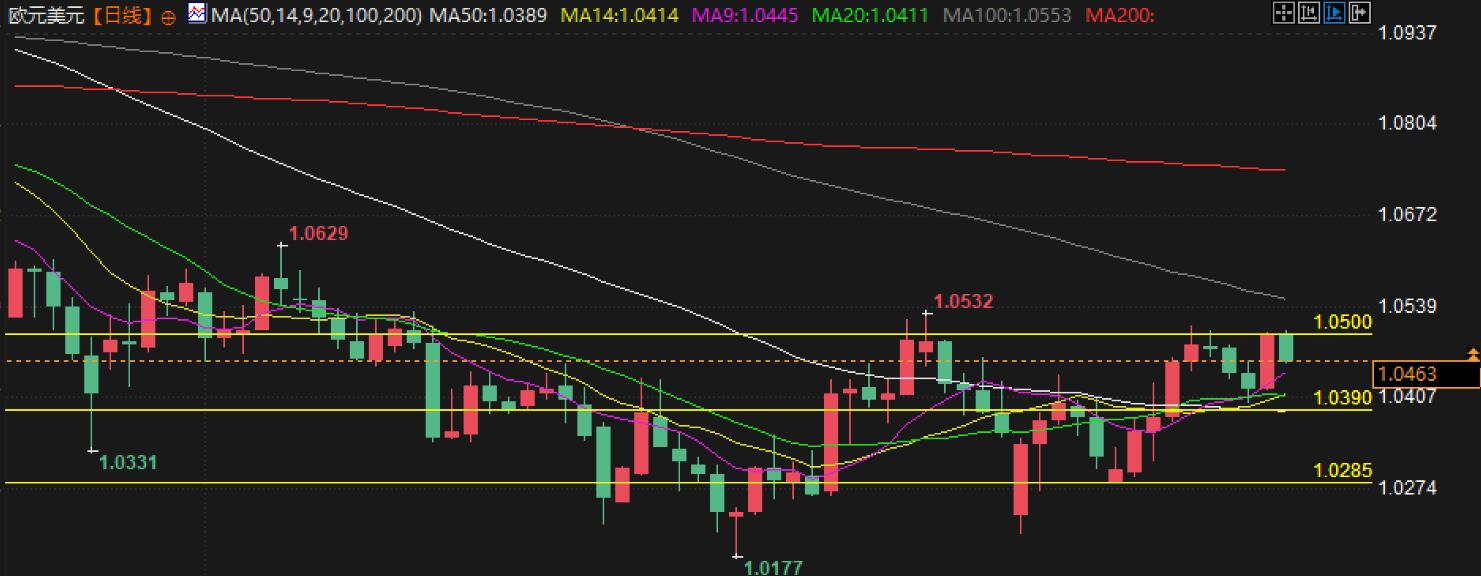Forex Trading Analysis: Euro/USD Rises and Falls, What's Next?
On Friday, February 21st, before the US market opened, the EUR/USD fell to around 1.0460. Affected by the preliminary data of the Eurozone Purchasing Managers' Index (PMI) for February released by the German Commercial Bank (HCOB), the euro has once again come under pressure.
According to the HCOB PMI report compiled by S&P Global, although overall business activity in the eurozone is still expanding, the growth rate is lower than market expectations. Specifically, the composite PMI index is 50.2, lower than the market expectation of 50.5, indicating a slowdown in the pace of economic expansion.
The report shows that the manufacturing PMI in the eurozone continues to contract, but the magnitude of the contraction has slowed down compared to before and is lower than expected; At the same time, service industry activities are expanding, but the growth rate has also slowed down compared to the previous period. This data indicates that although the Eurozone economy has maintained growth, the growth momentum is insufficient, especially in the manufacturing sector, which still faces challenges. The prospects of the German economy are still under market attention, and it is expected that government measures after the German election may bring some positive stimulus to the eurozone. However, the relatively unstable situation in France, coupled with the uncertainty brought by the US tariff policy, has raised doubts about the market's expectations for the economic recovery of the eurozone.
Cyrus de la Rubia, Chief Economist of HCOB, stated that although the decline in the manufacturing sector has slightly eased, the weak growth in the service sector is not enough to compensate for the weakness in the manufacturing industry. Therefore, the prospects for the recovery of the eurozone economy remain uncertain. The concerns about economic growth in the Eurozone have also led to ongoing concerns from the European Central Bank (ECB) about the upward risks of economic growth. The market has fully digested the expectation that the ECB may implement three interest rate cuts in 2025. It is worth noting that the European Central Bank has lowered its deposit rate by 25 basis points to 2.75% last month.
Technical analyst interpretation:
From a technical perspective, the euro/dollar fell back to around 1.0460 after breaking through a three week high of 1.0500. The 50 day moving average (EMA) of the index continues to provide support for the exchange rate (currently around 1.0390), indicating the short-term support role of this technical level.
On the 14th, the Relative Strength Index (RSI) has not been able to break through the level of 60.00. If RSI (14) can continue to stand above 60.00, it may trigger stronger upward momentum, which is crucial for the further rebound of the euro. However, the current RSI has not yet broken through this critical level, indicating that the buying momentum in the market is relatively limited in the short term, and breaking through 60.00 may require more market stimulus factors.

From a technical perspective of support and resistance, the downward support level for the euro/dollar appeared near the low of 1.0285 on February 10th, which is a key support area for the foreseeable future. If the exchange rate breaks below this level, it may trigger more bearish market conditions, and the target may point to lower support levels. On the upside side, the resistance level of 1.0630 is particularly important, which was the high point on December 6th. Breaking through this resistance level will mean that the bulls may further strengthen and bring new upward space for the euro.
In terms of K-line pattern, the short-term trend of EUR/USD shows a consolidation state, and the price has not yet formed a clear trend. If the price can steadily rise and break through the suppression of resistance above, it may usher in a short-term rebound. Conversely, if the price fails to break through the current resistance, it may maintain a volatile downward trend.
Conclusion:
The short-term trend of EUR/USD is still constrained by technical resistance. Pay attention to the two key price ranges of 1.0500 and 1.0285, especially whether RSI can break through 60.00 and the support level of the 50 day EMA. These will determine whether the short-term trend of the euro breaks through the oscillation range or continues to fall back to lower support levels.
Tips:This page came from Internet, which is not standing for FXCUE opinions of this website.
Statement:Contact us if the content violates the law or your rights
